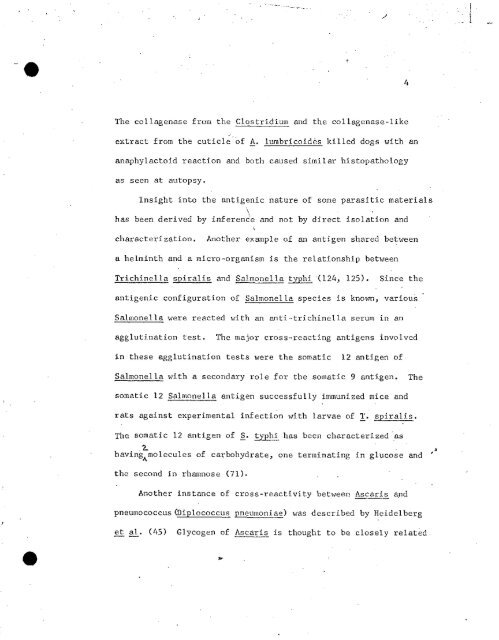CHARACTERIZATION OF PARASITE ANTIGENS ... - PAHO/WHO
CHARACTERIZATION OF PARASITE ANTIGENS ... - PAHO/WHO
CHARACTERIZATION OF PARASITE ANTIGENS ... - PAHO/WHO
Create successful ePaper yourself
Turn your PDF publications into a flip-book with our unique Google optimized e-Paper software.
e<br />
The collagenase from the Clostridium and the collagenase-like<br />
extract from the cuticle of A. lumbricoides killed dogs with an<br />
anaphylactoid reaction and both caused similar histopathology<br />
as seen at autopsy.<br />
Insight into the antigenic nature of sonie parasitic materials<br />
has been derived by inference and not by direct isolation and<br />
characterization. Another example of an antigen shared between<br />
a helminth and a micro-organism is the relationship between<br />
Trichinella spiralis and Salmonella typhi (124, 125). Since the<br />
antigenic configuration of Salmonella species is known, various<br />
Salmonella were reacted with an anti-trichinella serum in an<br />
agglutination test. The major cross-reacting antigens involved<br />
in these agglutination tests were the somatic 12 antigen of<br />
Salmonella with a secondary role for the somatic 9 antigen. The<br />
somatic 12 Salmonella antigen successfully immunized mice and<br />
rats against experimental infection with larvae of T. spiralis.<br />
The somatic 12 antigen of S. typhi has been characterized as<br />
having molecules of carbohydrate, one terminating in glucose and<br />
the second in rhamnose (71).<br />
Another instance of cross-reactivity between Ascaris and<br />
pneumococcus (iplooccus pneumoniae) was described by Heidelberg<br />
et al. (45) Glycogen of Ascaris is thought to be closely related<br />
4
















